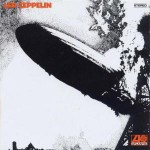 January 16, 1969 – That’s 43 years ago as of this writing – A new rock band burst on the American scene. And the landscape hasn’t been the same since. It’s a group that Rolling Stone to the raw energy and originality of the MC5 and the Stooges, and it evolved into one of the most successful acts of the 1970s.
January 16, 1969 – That’s 43 years ago as of this writing – A new rock band burst on the American scene. And the landscape hasn’t been the same since. It’s a group that Rolling Stone to the raw energy and originality of the MC5 and the Stooges, and it evolved into one of the most successful acts of the 1970s.
It all began five months earlier in England when the Yardbirds disbanded. The group hit three times on Keener, with “For Your Love”, “Shapes of Things”, “Over Under Sideways Down” and “Little Things”. But by August 1968, only Guitarist Jimmy Page remained. Obligated to perform additional dates in Scandinavia, Page, enticed bassist John Paul Jones, vocalist Robert Plant and drummer John Bonham to come along.
By the time the summer was over, the band had returned to England with a new name: Led Zeppelin, and a studio date at Olympic.
Even though, as individuals, Led Zeppelin had rock n roll street cred, they had yet to sign with a record company. So cost efficiency was the watch word and time was of the essence. Page later said that the entire album was recorded over several weeks, using just 36 hours of studio time at a cost of less than 2000 British Pounds. The material had been well rehearsed and test marketed to the Scandinavians so production went smoothly.
“I wanted artistic control in a vice grip,” Page told Guitar World magazine in 1993, “because I knew exactly what I wanted to do with these fellows. In fact, I financed and completely recorded the first album before going to Atlantic… It wasn’t your typical story where you get an advance to make an album—we arrived at Atlantic with tapes in hand… Atlantic’s reaction was very positive – I mean they signed us, didn’t they?”
Atlantic Records founder Ahmet Ertegun was a believer. “From the first time I heard the first cuts of their first album,” he told the Rock and Roll Hall of Fame, “I knew we had something that was undeniably great. Robert Plant was a revelation – a singer who had his own style of singing great old blues as well as new songs. John Bonham, a drummer without equal. Peter Grant, their manager, was a mountain of a man, and he kept them hidden in a shroud of mystery.”
The album cover is still considered one of the most striking of the rock era. It features a photograph of the German Zeppelin, Hindenburg, in full flame as it crashed to the ground at Lakehurst New Jersey on May 6, 1937.
It was the era of the Super Groups and Zeppelin had lots of competition. It didn’t help that the press reaction to the album was mostly negative. But as often happens, the public chose to listen to the band and not the critics. As Zeppelin’s concert tour progressed, interest in what we now call Led Zeppelin 1 started spinning up. 60 days later it was top ten on the Billboard chart and remained on the survey for 73 weeks.
Seven years later, the accountants totaled the take and Led Zeppelin 1 had earned more than $7 million dollars. Today, over 10 million copies have been sold. And that’s just here in the US.
Rolling Stone, initially critical of the album, sang it’s praises in 2006. “The arrangements were more sculpted than those of Cream or Jimi Hendrix, and the musicianship wasn’t cumbersome like Iron Butterfly‘s or bombastic like Vanilla Fudge‘s. The closest comparisons might be to MC5 or the Stooges—both from Michigan—yet neither had the polish or prowess of Led Zeppelin, nor did Led Zeppelin have the political, social or die-hard sensibility of those landmark bands. What they did have, though, was the potential for a mass audience.”
Rolling Stone certified the LP’s place in history in 2003 when it at put Led Zeppelin 1 at #29 in their listing of the top 500 albums of all time.

